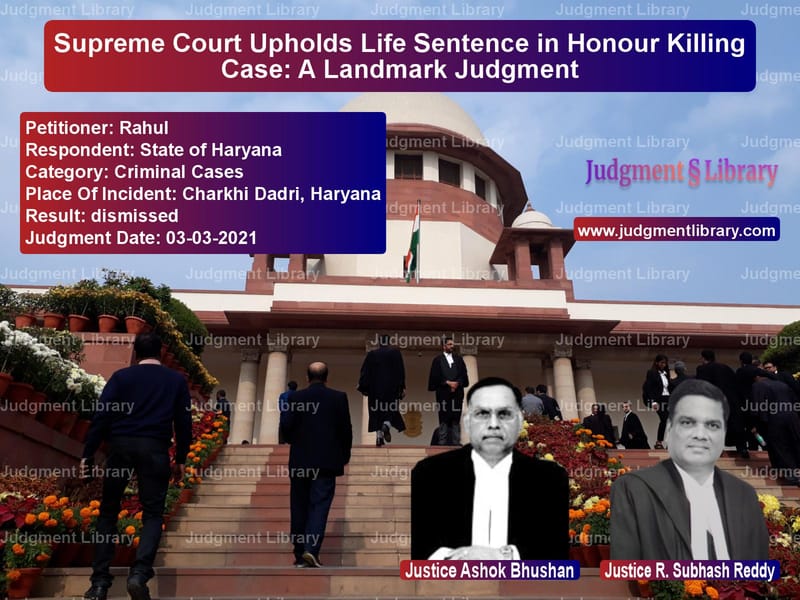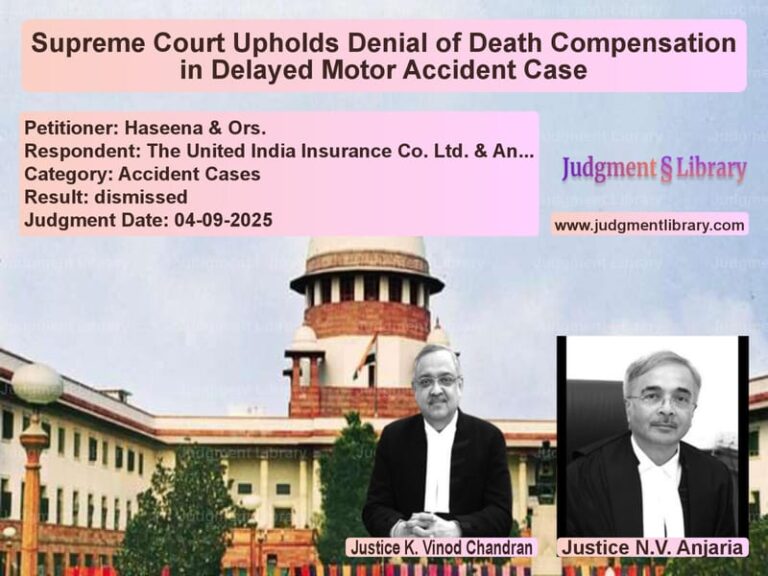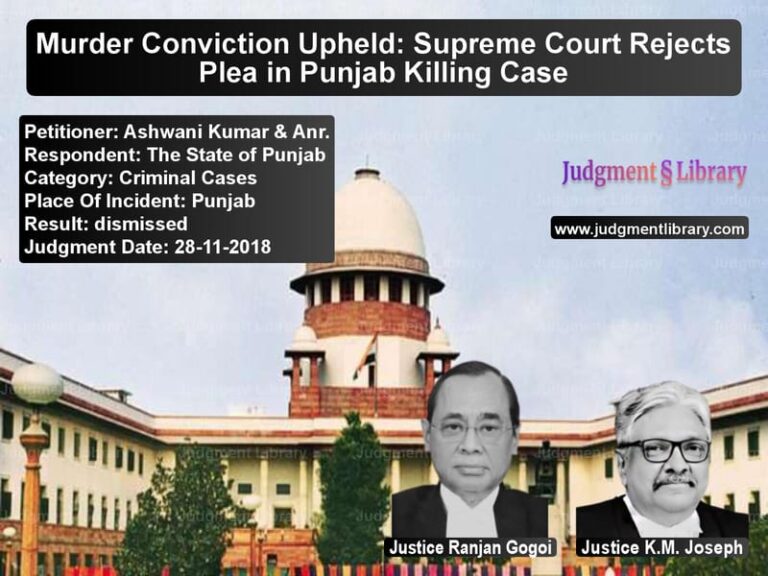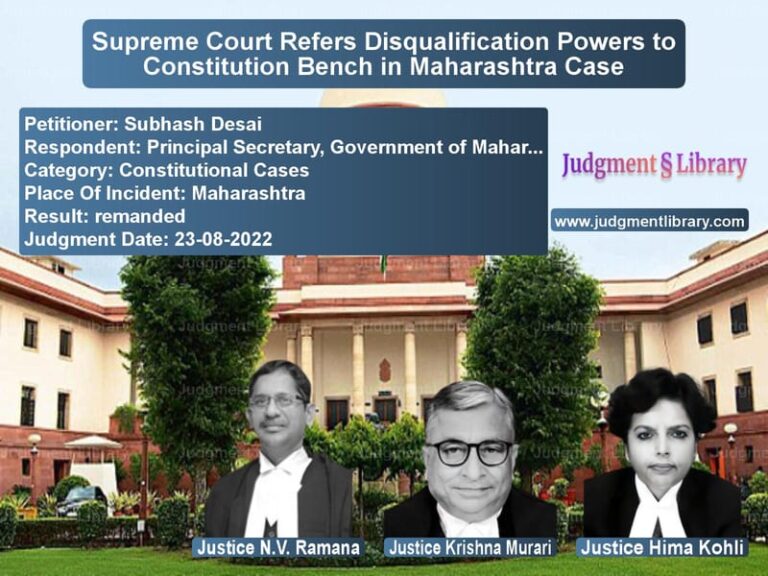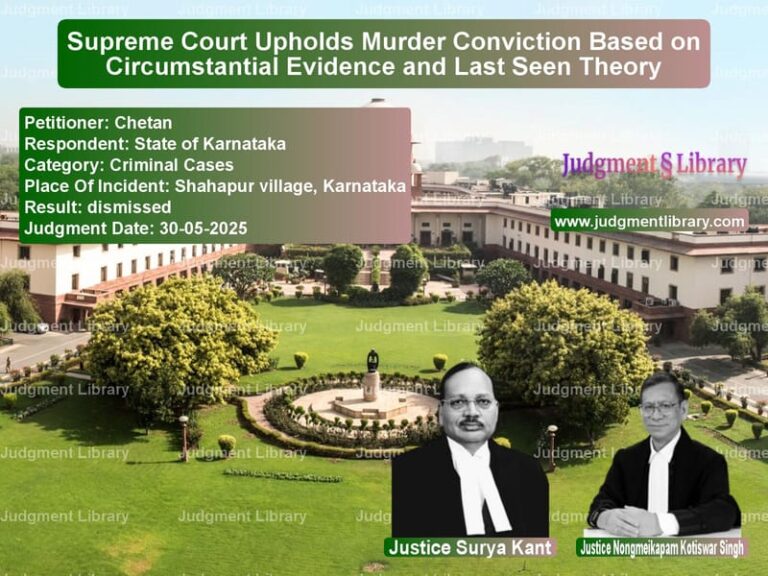Supreme Court Upholds Life Sentence in Honour Killing Case: A Landmark Judgment
The Supreme Court of India, in a significant ruling, upheld the conviction and life sentence of the appellant Rahul in a brutal honour killing case. The judgment, delivered in Rahul vs. State of Haryana, reaffirmed the principles of circumstantial evidence and last seen theory in murder cases. The Court found that the murder of Jitender, a young man, was carried out by the accused due to suspicions regarding his wife’s character, making it a classic case of honour killing.
Background of the Case
The case arose from a crime that took place on August 6, 2010, in Charkhi Dadri, Haryana. The police received information from a local resident about a dead body found in a pit on panchayat land near Kaliyana-Jhojhu road. Upon investigation, it was discovered that the deceased was Jitender, a young man who had been brutally murdered with firearm injuries.
Read also: https://judgmentlibrary.com/supreme-court-upholds-conviction-in-haryana-dowry-death-case/
The police collected crucial evidence, including spent cartridges, blood-stained earth, and tyre marks near the crime scene. The investigation led to the arrest of Rahul, a resident of Mirpur, who was the husband of Priyanka, the deceased’s alleged lover. Rahul was accused of conspiring with his father-in-law Ramesh and brother-in-law Ashok Kumar to murder Jitender.
The case was based on circumstantial evidence, with the prosecution arguing that Rahul lured Jitender to an isolated area and executed the murder due to suspicions about his wife’s fidelity.
Arguments by the Petitioner (Rahul)
- The conviction was based purely on circumstantial evidence without any direct eyewitness testimony.
- The prosecution’s reliance on the last seen theory was flawed, as there was no independent witness to corroborate that Jitender was last seen with Rahul.
- The key witnesses—Jitender’s mother (PW-12) and brother (PW-3)—were interested witnesses and their testimonies should not have been relied upon.
- The alleged recovery of the murder weapon was dubious and lacked proper corroboration.
- There were material contradictions in the prosecution’s case, including discrepancies in the forensic reports.
Arguments by the Respondents (State of Haryana)
- The prosecution presented a complete chain of evidence proving Rahul’s guilt beyond a reasonable doubt.
- The last seen theory was supported by multiple witnesses, including the deceased’s family members.
- Rahul had a clear motive to kill Jitender, as he believed his wife was in a relationship with him.
- The forensic examination confirmed that the bullet recovered from Jitender’s body matched the country-made pistol recovered from Rahul’s possession.
- The conviction was not based on suspicion alone but on a strong chain of circumstantial evidence.
Supreme Court’s Observations
The Supreme Court extensively examined the evidence and legal principles governing circumstantial evidence, highlighting the following key observations:
- Last Seen Theory: The Court held that the last seen theory can be relied upon when the time gap between the accused being last seen with the deceased and the time of death is narrow.
- Credibility of Witnesses: The Court rejected the argument that family members of the deceased are inherently unreliable witnesses, stating that their testimonies can be considered if corroborated by independent evidence.
- Weapon Recovery: The Court found that the recovery of the firearm and forensic analysis linking it to the crime supported the prosecution’s case.
- Motive: The motive behind the crime—suspicion about the wife’s character—was strongly established and added credibility to the prosecution’s case.
- Standard of Proof in Circumstantial Evidence: The Court reiterated that in cases relying on circumstantial evidence, the prosecution must establish a chain of events leading to the only plausible conclusion of the accused’s guilt.
The Court stated:
“The prosecution has established a clear and unbroken chain of circumstances that point unequivocally to the guilt of the accused. The last seen theory, corroborated by forensic evidence and motive, leaves no room for doubt.”
Supreme Court’s Verdict
- The Supreme Court dismissed Rahul’s appeal and upheld his conviction.
- The Court confirmed the sentence of life imprisonment imposed by the trial court.
- The Court noted that since Rahul had already served over 11 years in prison, he could apply for remission after completing 14 years.
Impact of the Judgment
- Reinforcement of Circumstantial Evidence Doctrine: The ruling reaffirms that a conviction can be based on circumstantial evidence if a complete chain of events is established.
- Strengthening Last Seen Theory: The judgment strengthens the jurisprudence around the last seen theory in criminal cases.
- Recognition of Honour Killing as a Grave Crime: The ruling sends a strong message against honour killings, emphasizing that suspicions about a spouse’s fidelity do not justify taking the law into one’s hands.
- Guidance on Forensic Evidence: The judgment highlights the importance of forensic analysis in criminal cases, particularly when there are no direct eyewitnesses.
Conclusion
The Supreme Court’s decision in Rahul vs. State of Haryana sets an important precedent in criminal law, particularly in cases involving honour killings and circumstantial evidence. The ruling underscores the importance of forensic evidence, the last seen theory, and motive in securing convictions in murder cases. By upholding Rahul’s life sentence, the Court reaffirmed its commitment to justice and the rule of law.
Petitioner Name: Rahul.Respondent Name: State of Haryana.Judgment By: Justice Ashok Bhushan, Justice R. Subhash Reddy.Place Of Incident: Charkhi Dadri, Haryana.Judgment Date: 03-03-2021.
Don’t miss out on the full details! Download the complete judgment in PDF format below and gain valuable insights instantly!
Download Judgment: rahul-vs-state-of-haryana-supreme-court-of-india-judgment-dated-03-03-2021.pdf
Directly Download Judgment: Directly download this Judgment
See all petitions in Murder Cases
See all petitions in Bail and Anticipatory Bail
See all petitions in Attempt to Murder Cases
See all petitions in Custodial Deaths and Police Misconduct
See all petitions in Judgment by Ashok Bhushan
See all petitions in Judgment by R. Subhash Reddy
See all petitions in dismissed
See all petitions in supreme court of India judgments March 2021
See all petitions in 2021 judgments
See all posts in Criminal Cases Category
See all allowed petitions in Criminal Cases Category
See all Dismissed petitions in Criminal Cases Category
See all partially allowed petitions in Criminal Cases Category

